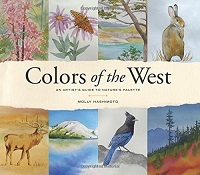![[Garden Revolution] cover](https://depts.washington.edu/hortlib/graphix/GardenRevolution.jpg)
The title Garden Revolution is hype. This new book by Larry Weaner and Thomas Christopher is instead a retreat, a going back to working with nature.
Yes, it does challenge many traditional horticultural practices. Primary author and long-time garden designer Weaner uses the term ecological gardening to describe his technique. He insists on working with the existing soil, exposure, and other elements of a site, choosing plants that thrive in the given conditions, instead of amending to the needs of plants you want. He also argues against most accepted weeding practices because they disturb the soil, encouraging more weed seeds to sprout.
Most of all, he wants the gardener and anyone who carefully observes a landscape to recognize that change is inevitable, but it can and should be embraced.
Why am I recommending this book to students and researchers in restoration? Because there is a lot of good horticulture that is very applicable to restoration sites. Weaner lives in the eastern United States, but his principles are quite adaptable and applicable.
He is blunt: “Ecological garden design is not a style of garden-making for the micro-manager. To be successful, this sort of design requires letting the landscape make many of the decisions.”
So perhaps this is a revolution. One that on a small scale has already proven successful.
Published in the March 2018 Leaflet for Scholars Volume 5, Issue 3.
 The story of Will Allen and his urban farming non-profit organization (described in his book “The good food revolution”)has inspired a book found in the children’s section of the Miller Library. “Farmer Will Allen and the Growing Table,” written by Jacqueline Briggs Martin and illustrated by Eric-Shabazz Larkin, focuses on the role neighborhood children played in helping Allen’s enterprise be successful.
The story of Will Allen and his urban farming non-profit organization (described in his book “The good food revolution”)has inspired a book found in the children’s section of the Miller Library. “Farmer Will Allen and the Growing Table,” written by Jacqueline Briggs Martin and illustrated by Eric-Shabazz Larkin, focuses on the role neighborhood children played in helping Allen’s enterprise be successful. Michelle Obama needs no introduction and even her book “American Grown,” describing the White House Kitchen Garden she started, is already well known. For some, this may be an easy book to dismiss as a public service announcement, or worse, as a political statement. This is unfortunate, because it is a good gardening book, both for techniques and as a model of how gardening improves people’s lives in many ways.
Michelle Obama needs no introduction and even her book “American Grown,” describing the White House Kitchen Garden she started, is already well known. For some, this may be an easy book to dismiss as a public service announcement, or worse, as a political statement. This is unfortunate, because it is a good gardening book, both for techniques and as a model of how gardening improves people’s lives in many ways. In describing her book, “The Color of Food,” Natasha Bowens explains, “I never would have imagined that my desire to dig in the dirt would lead me here, digging instead into the stories of farmers of color across America – Black, Latina, Native, and Asian farmer and food activists.” Initially, her interest in improving food and agriculture systems led her to working on organic farms, but often as the only “brown person” there. Through her blog (Brown.Girl.Farming), she discovers there are others like her, and decides their stories need telling.
In describing her book, “The Color of Food,” Natasha Bowens explains, “I never would have imagined that my desire to dig in the dirt would lead me here, digging instead into the stories of farmers of color across America – Black, Latina, Native, and Asian farmer and food activists.” Initially, her interest in improving food and agriculture systems led her to working on organic farms, but often as the only “brown person” there. Through her blog (Brown.Girl.Farming), she discovers there are others like her, and decides their stories need telling. Will Allen grew up on a small farm in the Maryland suburbs of Washington, D. C. His parents grew up as sharecroppers in western South Carolina, very close to the home of J. Drew Lanham. As a young man, he was embarrassed by his heritage, instead hoping to make his career as a basketball player.
Will Allen grew up on a small farm in the Maryland suburbs of Washington, D. C. His parents grew up as sharecroppers in western South Carolina, very close to the home of J. Drew Lanham. As a young man, he was embarrassed by his heritage, instead hoping to make his career as a basketball player. “The Home Place” is best described by its subtitle: “Memoirs of a Colored Man’s Love Affair with Nature.” J. Drew Lanham’s love for nature, especially of birds, and nurtured by his upbringing in rural, western South Carolina, is palpable throughout.
“The Home Place” is best described by its subtitle: “Memoirs of a Colored Man’s Love Affair with Nature.” J. Drew Lanham’s love for nature, especially of birds, and nurtured by his upbringing in rural, western South Carolina, is palpable throughout. Dianne Glave is very clear about the main argument of her book, “Rooted in the Earth”. “Stereotypes persist that African Americans are physically and spiritually detached from the environment. This wrongheaded notion is so ingrained in our culture that many of us have begun to believe it ourselves. But nothing could be less true.”
Dianne Glave is very clear about the main argument of her book, “Rooted in the Earth”. “Stereotypes persist that African Americans are physically and spiritually detached from the environment. This wrongheaded notion is so ingrained in our culture that many of us have begun to believe it ourselves. But nothing could be less true.”
